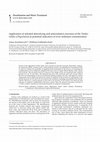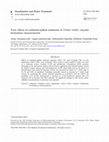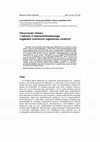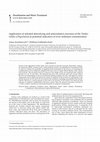Papers by Anna Arendarczyk
Archives of Environmental Protection, 2011
In the paper toxicity assessment of hospital wastewaters samples was performed using direct-conta... more In the paper toxicity assessment of hospital wastewaters samples was performed using direct-contact tests consisting of five species, which represent three different trophic levels of the food chain. IC 50 or EC 50 values were estimated for each tested organism: subcapitata IC 50/72h 18.77%, Daphnia magna EC 50/48h 20.76%, Thamnocephalus platyurus EC 50/24h 22.62%, Artemia salina EC 50/24h 59.87% and Vibrio fisheri EC 50/15min 46.17%. Toxic potential of hospital wastewater was described using a system of wastewater toxicity classification. The toxic units (TU) values estimated for each test indicate that hospital wastewaters are toxic (Class III). The variable results of the tests' sensitivity confirmed the need of application of microbiotests battery with organisms of different trophic levels.

DESALINATION AND WATER TREATMENT, 2020
Tissues of the oligochaete Tubifex tubifex were assayed for selected enzymatic biomarkers: supero... more Tissues of the oligochaete Tubifex tubifex were assayed for selected enzymatic biomarkers: superoxide dismutase (SOD), catalase (CAT), carboxylesterase (CarE), and glutathione-S-transferase (GST) in order to evaluate the possibility of applying those biomarkers in the process of evaluating the contamination of river sediments sampled from four rivers in Upper Silesia: Bajerka, Odra, Jamna, and Gostynia. The enzymatic activity in tissues of the sludge worm was measured after exposure periods of 4, 24, 72, and 168 h. The obtained data led to the conclusion that CarE activity reflects the level of contamination of the environmental sediment samples, not only with regard to organic compounds such as PAHs, but also heavy metals. In addition to the increase in CarE activity, a significant decrease in GST and CAT was noted for the sediment containing unacceptable PAH concentrations. Moreover, a strong response in the form of an increase in GST activity was observed after exposure to sediment contaminated with heavy metals. Thus, the analyzed enzymatic activities of T. tubifex could be considered a potentials biomarker of sediment contamination.

Desalination and Water Treatment, Feb 11, 2014
Effects of cadmium-spiked sediment exposure (0.001, 0.01, and 0.1 mg•kg -1 dm.) on the oligochaet... more Effects of cadmium-spiked sediment exposure (0.001, 0.01, and 0.1 mg•kg -1 dm.) on the oligochaete Tubifex tubifex were evaluated. CdCl 2 which is easily soluble in water was used as a cadmium source. Catalase (CAT) and gluthatione S-transferase (GST) enzymes belonging to the antioxidant system which protects organisms from harmful impact caused by reactive oxygen species and carboxylesterase (CarE) which takes part in the phase I of detoxification were analyzed. Enzyme activity was measured in tissues of T. tubifex after 4, 24, 72, and 168 h of exposition. Cadmium, generally, caused an increase in T. tubifex CarE activity by comparing the control sediment prepared in accordance with the OECD 233 guideline. CAT activity demonstrates a decrease in a dose-responsive manner after 4-h exposure and an increase after 24-h exposure. No significant changes in GST activity under sublethal concentrations of cadmium were reported.

Analizowano wpoyw chlorku 1-heksylo-3-metyloimidazoliowego, b edącego komercyjnie dost epnym prek... more Analizowano wpoyw chlorku 1-heksylo-3-metyloimidazoliowego, b edącego komercyjnie dost epnym prekursorem cieczy jonowych. Przeprowadzone badania ekotoksykologiczne obejmowaoy oznaczenie wpoywu testowanej substancji na wschody oraz wzrost korzenia i oodygi pszenicy (Triticum aestivum ) i rzodkwi (Raphanus sativus ). Przeprowadzono rownie Ŝ ocen e toksyczno ści ostrej z wykorzystaniem organizmow zwierz ecych, soonowodnych skorupiakow Artemia salina , oraz toksyczno ści chronicznej z wykorzystaniem skorupiakow Heterocypris incongruens . Stwierdzono toksyczne oddziaoywanie chlorku 1-heksylo-3-metyloimidazoliowego na zdolno śc kieokowania obu ro ślin testowych, natomiast nie odnotowano efektu toksycznego wzgledem takich parametrow, jak wzrost korzenia i oodygi pszenicy oraz rzodkwi. Badany związek sklasyfikowano jako nietoksyczny w stosunku do skorupiakow Artemia salina , natomiast w te ście z wykorzystaniem H. incongruens wykazano jego toksyczny wpoyw. Warto śc EC 50 wyznaczona w tym te...

Dokonano oceny potencjalu toksykologicznego imidazoliowej cieczy jonowej o nazwie chlorek 1-heksy... more Dokonano oceny potencjalu toksykologicznego imidazoliowej cieczy jonowej o nazwie chlorek 1-heksylo-3-metyloimidazoliowy (CHM). Zakres badan ekotoksykologicznych obejmowal przeprowadzenie testu toksyczności ostrej z wykorzystaniem skorupiakow slodkowodnych (Thamnocephalus platyurus) i testu toksyczności chronicznej z wykorzystaniem bakterii morskich (Vibrio fischeri). Wartości wskaźnikow ekotoksykologicznych wyznaczone w poszczegolnych testach wyniosly odpowiednio: EC50 2,51 mg/dm (THAMNOTOXKIT F) i EC50/5min 15,30 mg/dm i EC50/15min 14,40 mg/dm (MICROTOX Basic Test 81,9%). Na podstawie uzyskanych wynikow związek sklasyfikowano jako toksyczny. W ramach badan dokonano rowniez oceny wplywu korekty odczynu i napowietrzania na redukcje toksyczności roztworu CHM. Doświadczenie przeprowadzono zgodnie z metodyką US EPA/600/6-91/005F. Stwierdzono, ze korekta odczynu roztworu CHM do poziomu 3 i 11, a takze przeprowadzenie symultanicznego procesu korekty pH do 3 i napowietrzania wplywa na obn...

DESALINATION AND WATER TREATMENT, 2020
Tissues of the oligochaete Tubifex tubifex were assayed for selected enzymatic biomarkers: supero... more Tissues of the oligochaete Tubifex tubifex were assayed for selected enzymatic biomarkers: superoxide dismutase (SOD), catalase (CAT), carboxylesterase (CarE), and glutathione-S-transferase (GST) in order to evaluate the possibility of applying those biomarkers in the process of evaluating the contamination of river sediments sampled from four rivers in Upper Silesia: Bajerka, Odra, Jamna, and Gostynia. The enzymatic activity in tissues of the sludge worm was measured after exposure periods of 4, 24, 72, and 168 h. The obtained data led to the conclusion that CarE activity reflects the level of contamination of the environmental sediment samples, not only with regard to organic compounds such as PAHs, but also heavy metals. In addition to the increase in CarE activity, a significant decrease in GST and CAT was noted for the sediment containing unacceptable PAH concentrations. Moreover, a strong response in the form of an increase in GST activity was observed after exposure to sediment contaminated with heavy metals. Thus, the analyzed enzymatic activities of T. tubifex could be considered a potentials biomarker of sediment contamination.

Desalination and Water Treatment, 2014
Effects of cadmium-spiked sediment exposure (0.001, 0.01, and 0.1 mg•kg -1 dm.) on the oligochaet... more Effects of cadmium-spiked sediment exposure (0.001, 0.01, and 0.1 mg•kg -1 dm.) on the oligochaete Tubifex tubifex were evaluated. CdCl 2 which is easily soluble in water was used as a cadmium source. Catalase (CAT) and gluthatione S-transferase (GST) enzymes belonging to the antioxidant system which protects organisms from harmful impact caused by reactive oxygen species and carboxylesterase (CarE) which takes part in the phase I of detoxification were analyzed. Enzyme activity was measured in tissues of T. tubifex after 4, 24, 72, and 168 h of exposition. Cadmium, generally, caused an increase in T. tubifex CarE activity by comparing the control sediment prepared in accordance with the OECD 233 guideline. CAT activity demonstrates a decrease in a dose-responsive manner after 4-h exposure and an increase after 24-h exposure. No significant changes in GST activity under sublethal concentrations of cadmium were reported.
Archives of …, 2011
In the paper toxicity assessment of hospital wastewaters samples was performed using direct-conta... more In the paper toxicity assessment of hospital wastewaters samples was performed using direct-contact tests consisting of five species, which represent three different trophic levels of the food chain. IC 50 or EC 50 values were estimated for each tested organism: subcapitata IC 50/72h 18.77%, Daphnia magna EC 50/48h 20.76%, Thamnocephalus platyurus EC 50/24h 22.62%, Artemia salina EC 50/24h 59.87% and Vibrio fisheri EC 50/15min 46.17%. Toxic potential of hospital wastewater was described using a system of wastewater toxicity classification. The toxic units (TU) values estimated for each test indicate that hospital wastewaters are toxic (Class III). The variable results of the tests' sensitivity confirmed the need of application of microbiotests battery with organisms of different trophic levels.

Uploads
Papers by Anna Arendarczyk